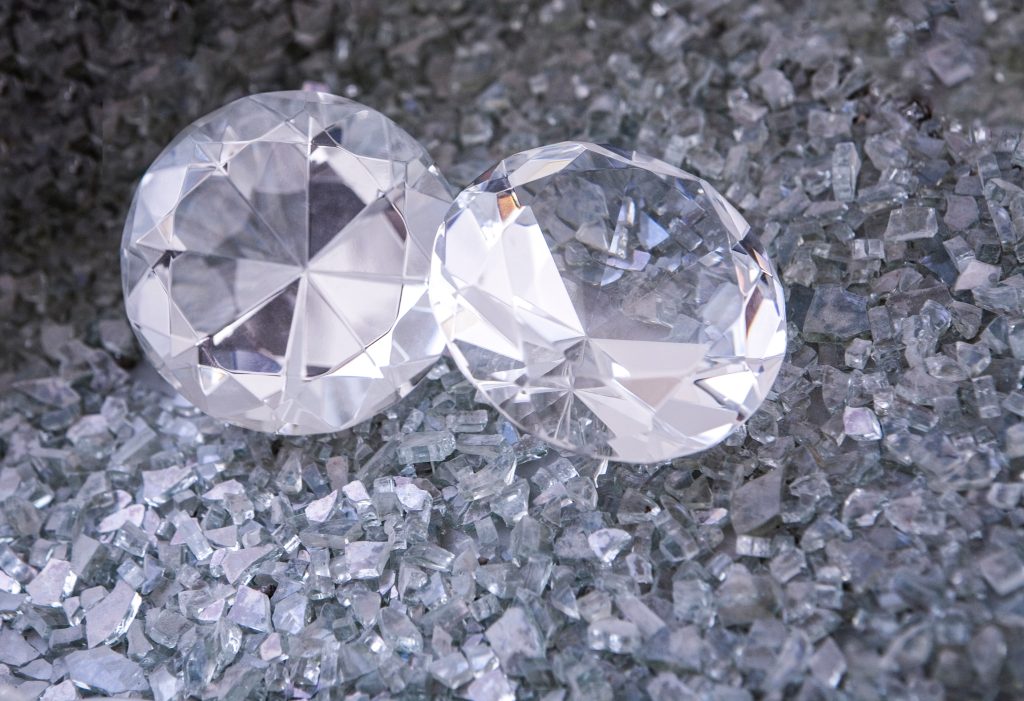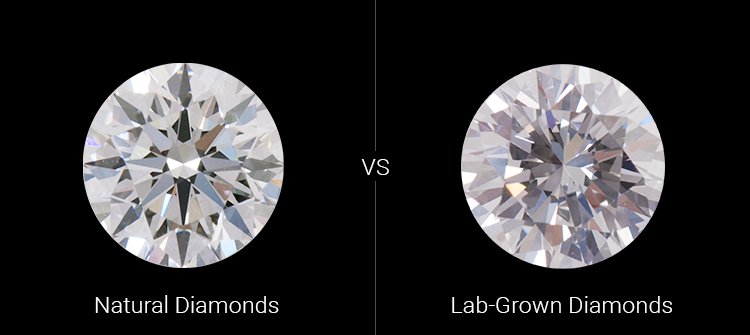The topic of lab-grown diamonds is somewhat controversial. Lab diamonds have received a lot of attention in recent years, both positive and negative. Whether to buy artificial or natural diamonds is at least something to consider when buying a diamond.
Natural diamonds are created naturally under the influence of high temperature and pressure, formed over billions of years. Lab-grown diamonds are often produced in a lab in just a few weeks. There are some chemical differences between the two because natural diamonds contain very little nitrogen, while synthetic diamonds do not. However, this is the only unique difference. The US Federal Trade Commission, or FTC, also classifies man-made diamonds as “real” diamonds due to the carbon-based chemistry of gemstones.

How Can You Tell the Difference Between a Lab Diamond and a Natural Diamond?
There is no noticeable difference between them. Even a professional gemologist needs special equipment to figure out which one. When zoomed in, experts can discern slight contrasts in the inclusions of lab-grown diamonds.
How to Check Diamond’s Certification?
The best way to tell the difference is to check the diamond’s certification. Gemstones must indicate whether the diamond is natural or synthetic. So as long as you’re shopping at a reputable store, you’ll always have this information at your fingertips. Keep in mind that this information has a significant impact on the diamond price and resale value.
Should You Buy a Lab Diamond or a Natural Diamond?
If there is no visible difference between a lab-grown diamond and a natural diamond, which one should you go for?
It’s hard to answer this question for everyone, as different buyers have different priorities. If appearance is literally the only factor that matters to you, then it doesn’t matter if a diamond is man-made or natural. No one will notice unless you tell them.
There are, however, some big differences, which should cause you to think twice when making your decision.
When you are considering purchasing a diamond, you might wonder if a lab-grown diamond is as beautiful as its natural counterpart. The answer to that question depends on your priorities. While one buyer may not care about the differences between a natural and lab-grown diamond, another may. If appearance is your only concern, a man-made diamond is likely to be a more durable investment. In either case, a large difference should cause you to think twice before purchasing.
Cost
In addition to cost, the rarity factor of a natural diamond is important. A diamond with an unusually low supply of natural diamonds will always be more valuable than a synthetic one. The limited supply of natural diamonds also causes demand to increase, making the gemstone even more desirable. The same can’t be said for lab-grown diamonds, however, since they can be mass-produced and have a lower price tag. However, the low price does not mean that lab-grown diamonds won’t hold their value over time, as the market is flooded with artificially-grown diamonds.
The cost of lab diamonds is still in constant flux. Just 3-4 years ago, we found lab diamonds on average 23-25% more expensive than natural diamonds. Today, lab diamonds are coming in significantly cheaper than natural diamonds. From 50-60% cheaper, or even more in some cases.
The difference is due to supply. The natural diamond supply is limited, due to the billions of years it takes for nature to create a diamond. Yet with synthetic diamonds, there is no cap on the supply, which drives the price lower and lower as the supply goes up.
The price difference between natural and synthetic diamonds is greater than the difference in resale value. Lab-created diamonds are nearly hard to market without accepting cents on the dollar, whereas natural diamonds maintain roughly 50% of their initial value. When you buy something, you lose a significant portion of its worth the instant you buy it.
We must also take into account how the price of real diamonds vs. synthetic diamonds fluctuates over time. Even before factoring in the difference in resale value, your synthetic diamond will most likely be worth less than a natural diamond of equal grade, with lab-created diamonds declining in price and natural diamonds historically gaining in value.
Sustainability
Some may have concerns over the environmental and humanitarian repercussions of natural diamond mining processes.
That’s not to say that natural diamonds are necessarily unethical. But it stands to reason that man-made diamonds offer more in the way of long-term sustainability than those pulled from the earth.
There is some contention over this issue. In fact, the FTC warned a number of jewelers about making unsubstantiated claims of their jewelry are sustainable or eco-friendly.
A report from the Diamond Producers Association claims that natural diamonds are, in fact, better for the environment than synthetic diamonds, due to the carbon-intensive process of producing lab diamonds. All in all, it appears there is not a consensus just yet on whether lab diamonds are actually a more sustainable option.
See this article for a comprehensive guide on ethical issues in diamond buying.
Shapes
The shapes of natural and lab-grown diamonds are not identical. The artificial process that is used to create a lab-grown diamond takes only two weeks, which makes the difference less obvious to the naked eye. The differences between natural and lab-grown diamonds are visible to trained professionals. However, the differences are negligible when compared to the prices of natural diamonds. In addition, many lab-grown diamonds are color-treated to give them a unique look.
Quality
As far as quality is concerned, laboratory-grown diamonds are more affordable than their natural counterparts. A good cut and a high-quality diamond certificate will ensure that you get a quality diamond for a reasonable price. A lab-grown diamond is often easier to spot than a natural diamond. A lab-grown diamond can be a great choice for your ring. If you’re unsure, James Allen has a link for you to perform a search that includes the Gem Society’s recommended parameters.
If you’re not a certified gemologist, you can purchase a lab-grown diamond. The chemical makeup of these diamonds is identical to that of a natural diamond. Neither can be distinguished by the naked eye. Even a gemologist cannot tell the difference between a natural and lab-grown diamond. However, you can choose between a natural and a lab-grown diamond for your engagement ring, and the quality of each is comparable.
While lab-grown diamonds can be much cheaper, they still cannot compete with natural diamonds in the long run. In fact, they may become worth next to nothing in the future. If you can afford both a natural and a lab-grown diamond, it is best to find a lab-grown diamond that’s conflict-free. However, if you cannot afford a natural diamond, you should consider other options that are more meaningful to you.
Another Advantage
Another advantage of lab-grown diamonds is that they are environmentally friendly. While mining for natural diamonds degrades the land, most diamond mining companies are taking steps to minimize the effect on ecosystems. And unlike natural diamonds, lab-grown diamonds use less energy and are much more durable. As a result, they are a better choice for a couple’s engagement ring. If you’re not sure which one to choose, talk to your jeweler today.
Physical Properties
A lab-grown diamond has the same physical properties as a natural diamond but is created in a controlled environment. Its color, clarity, and sparkle are identical to those of a natural diamond. It can even be the same size as a natural diamond. Unlike the natural diamond, a lab-grown diamond can be purchased for up to 40% less. This difference is not significant if you’re concerned about the source of your diamond.
FAQ About Lab Diamonds vs Natural Diamonds –
Are Lab-Created Diamonds Good?
To the look, to the touch, and chemically, lab-created diamonds are almost identical to “real” or natural diamonds. They are also cheaper, and some consider them a more environmentally conscious choice. However, the long-term value of lab diamonds is significantly lower than natural diamonds.
Are Lab Diamonds as Strong as Natural Diamonds?
Lab diamonds are as strong and as hard as natural diamonds, both scoring a 10 on the Mohs scale of hardness.
Can a Jeweler Tell if a Diamond is Lab-Created?
For even jewelers or professional gemologists, it’s often not possible to tell the difference between a natural and a lab-created diamond with the naked eye. But with specialized equipment, a gemologist may be able to tell small inclusions that identify a lab-created diamond.
Will Lab Diamonds Pass a Diamond Tester?
Yes. Lab diamonds are real diamonds, made from pure crystallized carbon, and will pass any tests to prove such.
Do Lab Diamonds Shine Like Natural Diamonds?
Yes, lab diamonds carry the same shine and sparkle, the same color and clarity as mined diamonds. There is no difference, other than the creation process.
How Much is a 1-Carat Lab Diamond?
The cost of lab diamonds can fluctuate, but on average, a 1-carat lab diamond will cost between $1,000-$2,000, or more depending on its grade.
Are Lab-Grown Diamonds GIA Certified?
Lab diamonds are graded on the same scale of Cut, Clarity, Color, and Carat weight as natural diamonds. The GIA does certify lab-grown diamonds, however, since they have just started, they aren’t that many of them. We recommend IGI certifications for lab diamonds, as they also give specific grades for Color and Clarity and are much easier to find.
What is the Difference Between a Lab-Created Diamond and a Cubic Zirconia?
A lab-created diamond is a real diamond, whereas cubic zirconia is not. Cubic zirconia does not contain carbon, so does not qualify as a diamond. A stimulant like cubic zirconia is less hard and does not look quite the same to the naked eye, unlike a lab diamond, which has the same look and physical properties as a natural diamond
Conclusion
The best way to decide between natural and lab-grown diamonds is to research the origin of the stone. Diamonds are created in a factory or laboratory and are created using a specialized technique. However, these diamonds are currently more expensive than natural diamonds. Although new technologies are expensive, they will continue to become more efficient, more affordable, and ultimately, more accessible.
This means that you might be able to find a lab-grown diamond that is affordable in the future. The other benefit of lab-grown diamonds is that they are not finite, unlike their natural counterparts. That means there is an endless supply of lab-grown diamonds.







